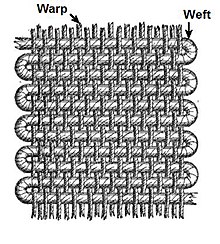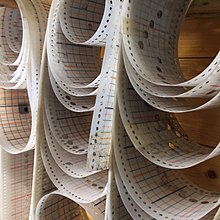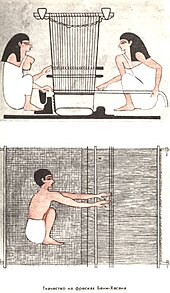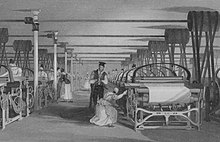Weaving
Weaving is a method of textile production in which two distinct sets of yarns or threads are interlaced at right angles to form a fabric or cloth.In general, weaving involves using a loom to interlace two sets of threads at right angles to each other: the warp which runs longitudinally and the weft (older woof) that crosses it.The two main stop motions are the The principal parts of a loom are the frame, the warp-beam or weavers beam, the cloth-roll (apron bar), the heddles, and their mounting, the reed.The "picking" on a power loom is done by rapidly hitting the shuttle from each side using an overpick or underpick mechanism controlled by cams 80–250 times a minute.[15] According to the find, the weavers of the Upper Palaeolithic were manufacturing a variety of cordage types, produced plaited basketry and sophisticated twined and plain woven cloth.[17][18] In 2013 a piece of cloth woven from hemp was found in burial F. 7121 at the Çatalhöyük site,[19] suggested to be from around 7000 BCE[20][21] Further finds come from the Neolithic civilisation preserved in the pile dwellings in Switzerland.Dating from 4900 to 6500 BCE and made from plant fibres, the Windover hunter-gatherers produced "finely crafted" twined and plain weave textiles.[35] Andean textile weavings were of practical, symbolic, religious, and ceremonial importance and used as currency, tribute, and as a determinant of social class and rank.Silk that was intricately woven and dyed, showing a well developed craft, has been found in a Chinese tomb dating back to 2700 BCE.Women usually married into the occupation, belonged to a family of weavers and or lived in a location that had ample weather conditions that allowed for the process of silk weaving.These workshops took care of the weaving process, although the raising of the silkworms and reeling of the silk remained work for peasant families.By the Middle Ages such devices also appeared in Persia, Sudan, Egypt and possibly the Arabian Peninsula, where "the operator sat with his feet in a pit below a fairly low-slung loom".Similarly, Indonesia has the Songket, also used in traditional weddings, which also utilizes gold and silver wrapped thread to create elaborate designs on their weaved textiles.On the other hand, Cambodia has the Ikat, which utilizes the method of dyeing thunks of thread tied with fiber to create patterns while weaving.Additionally, its increasing appearance in certain regions of Southeast Asia back then may be also a sign of the enlargement of cotton thread and textile production.Due to its low cost and portability because of its small size, it was favored among rural weaving communities in countries of Southeast Asia.[59] The merchants' prosperity is reflected in the wool towns of eastern England; Norwich, Bury St Edmunds and Lavenham being good examples.The opening of the Bridgewater Canal in June 1761 allowed cotton to be brought into Manchester, an area rich in fast flowing streams that could be used to power machinery.A large metal manufacturing industry grew to produce the looms, firms such as Howard & Bullough of Accrington, and Tweedales and Smalley and Platt Brothers.Richard Guest in 1823 made a comparison of the productivity of power and handloom weavers: A very good Hand Weaver, a man twenty-five or thirty years of age, will weave two pieces of nine-eighths shirting per week, each twenty-four yards long, and containing one hundred and five shoots of weft in an inch, the reed of the cloth being a forty-four, Bolton count, and the warp and weft forty hanks to the pound, A Steam Loom Weaver, fifteen years of age, will in the same time weave seven similar pieces.[77] From expressionist tapestries to the development of soundproofing and light-reflective fabric, the workshop's innovative approach instigated a modernist theory of weaving.[80] Hand weaving of Persian carpets and kilims has been an important element of the tribal crafts of many of the subregions of modern day Iran.This program helps create opportunities for women weavers throughout the Southeast Asia region to improve their livelihoods and to give them financial independence.Also, this association collaborates with academic institutions, government agencies and other non-government organizations on research and product development to be able to offer economic opportunities for communities.[86] Often they would be half timers, carrying a green card which teacher and overlookers would sign to say they had turned up at the mill in the morning and the afternoon at the school.[88] At fourteen or so they come full-time into the mill, and started by sharing looms with an experienced worker where it was important to learn quickly as they would both be on piece work.[94] Instigated by the artist and writer William Morris (1834–1896) during the 1860s[93] and inspired by the writings of John Ruskin (1819–1900), it had its earliest and most complete development in the British Isles[94] but spread to Europe and North America.[95] It was largely a reaction against mechanisation and the philosophy advocated of traditional craftsmanship using simple forms and often medieval, romantic or folk styles of decoration.His definition of "low" art was likely informed by years of theory against decoration and ornamentation, which was correlated with femininity in the early 1900s by critics like Adolf Loos and Karl Scheffler.[109] Women weavers, like Anni Albers, Lenore Tawney, Magdalena Abakanowicz, Olga de Amaral, and Sheila Hicks, are now the subject of exhibitions and major retrospectives across the world.

















Weaving (disambiguation)plain weavingsatin weavetextileyarns or threadsfabricknittingcrochetingfeltingbraiding or plaitingtablet weavingback strap loomplain weavetwill weavePower loomBangladesh Ansarright anglesOld EnglishparallelheddlesshuttleIsle of SkyePicanolgraphical user interfacepoplintaffetapibionesgrosgrainsatinssateensJacquardfabricsvelvetsvelveteensSelvageThrumstapestryPaleolithicDolní VěstoniceGuitarrero CaveÇatalhöyükNeolithicpile dwellingsNile ValleyWindover Archaeological SiteFloridahunter-gatherersmattingCabbage palmsaw palmettoscrub palmettoMacedoniaOlynthusPhilip IIMeroëAksumiteTextile arts of indigenous peoples of the AmericasAndean textilesAndean civilizationsNuevo LeónIndigenous people of the AmericascottoncamelidsllamasalpacasInca Empirebackstrap loomsheddleUkiyo-eYōshū Chikanobusericulturespecialized workshopscocoonsdraw-loomKhotanPedalsPersiaByzantiumMoorish SpainKashgarPhilippinesethnic groupsabacábananatree cottonburi palmbarkclothSagung CavePalawanArku CavePeñablanca, CagayanT'nalakT'boliNürnbergmedieval periodnettleclothSicilyNormansNorthern ItalyWarp-weighted loomsmerchant guildstrade guildsputting outmerchantNorwichBury St EdmundsLavenhamspinning wheelHundred Years WarBlack DeathFlorenceBrugesfactory systemHuguenot WeaversCalvinistsColonial AmericaGreat BritainWool Act 1699cotton ginTextile manufacture during the Industrial RevolutionIndustrial Revolutionputting-out systemapprenticeJohn Kayflying shuttleBridgewater Canal
